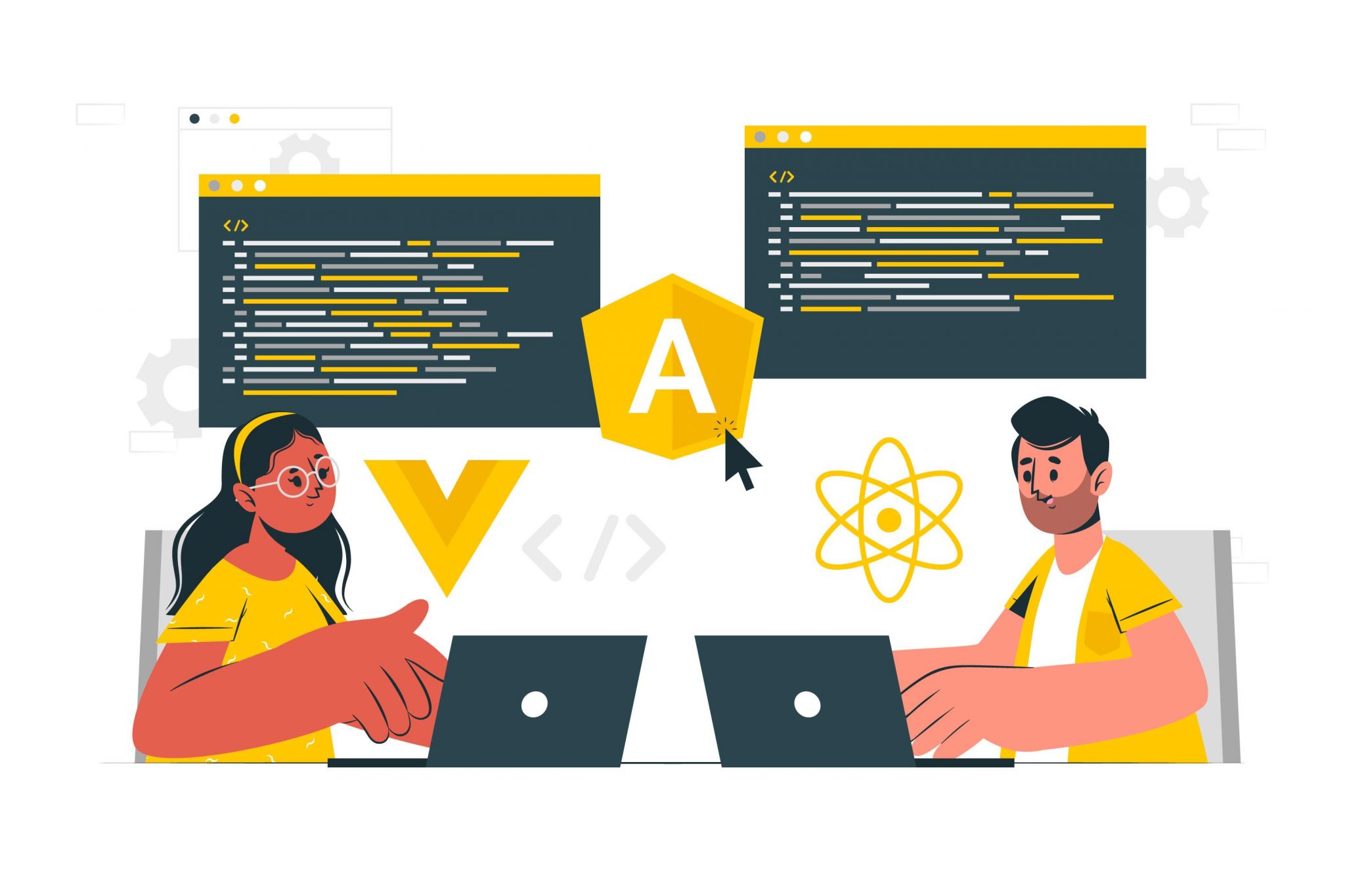Netflix, Swiggy, Instagram, Facebook, and Zomato were the first few to strategize a user-centric approach to come into the limelight. For hooking into the minds of the end-user to discover the factors that are simple and engaging, creating apps with a rich user interface was a eureka moment. The result was the ‘User Interface’ which was a game-changer in the industry.
Every organization is now focusing on user interfaces, making it their priority for the digital world. The hard work that goes into the background of developing the UI results in an eye-catching experience. This is a simple, concise, clean, and structured UI, continuing to build a consistent experience without limiting the functionality of the UI. To stay ahead and gain a competitive edge, business owners must invest in the right web development frameworks or hire dedicated developers from a frontend development company.
So, which are the best frontend framework in 2024, which framework will do wonders for your business? Let’s explore it in detail and move on to implement a complete dynamic solution.
What is Frontend Framework?
Before we get started with the best frontend framework, let’s have a look at exactly what is frontend framework? A frontend framework is a set of prewritten code that is used by developers in order to create a user interface for a website or a web application. It offers Developers, responsive web apps in no time with sophisticatedly organized.
Let’s have a look at the popular features of front-end frameworks:
| Sr. No | Popular Front End Features |
| 1. | Performance Optimization |
| 2. | Responsive Design |
| 3. | Components and Templates |
| 4. | JavaScript Utilities and Libraries |
| 5. | AI can power chatbots and virtual assistants can answer customer questions, process simple requests, and even provide basic policy information |
What are Web Development Frameworks?
‘Framework’ is a code-related word in Web development. These frameworks come under three different categories, viz. Frontend, Backend, and CSS/UI (user interface). In this blog, we are focusing on front-end and UI-specific frameworks. A framework is a structure and logic that facilitates the easy and efficient development and maintenance of larger projects. Like software, it is a collection of fundamental modules that would usually include pre-configured code. These codes come in handy for programmers to fix common programming tasks such as handling AJAX requests or file-defining structures. Frameworks would also specify rules to develop the UI architecture skeleton, which is adaptive, flexible, and scalable. Code libraries, utility programs, and scripting languages are a few examples of frameworks. A framework is a developer’s tool that helps the front end developer start a project from the foundation for implementing project-specific features.
A front-end framework is the graphical user interface of a website or application in the web development process. This is the engaging and visual part of the website for the end-users. Hence, this is a crucial section that needs to be user-friendly.
Factors to consider while choosing the best Frontend Framework in 2024
| Sr. No. | Factors to consider while choosing the best frontend framework |
| 1. | Project requirements |
| 2. | Performance |
| 3. | Ecosystem and Libraries |
| 4. | Scalability and Maintainability |
| 5. | Performance of Updates, Maintenance & Security |
Type of a website or an application needed: Best Frontend Framework
A larger application or a more dynamic website would be an important point to consider. Will it be a more interactive website or will it be a feature-loaded application? This will help you decide the framework that best works for you.
Adaptive yet simple framework:
As the developers will work on multiple projects simultaneously, the framework needs to be adaptive and simple. This would increase the efficiency and time-to-market of the website or application in the competitive market landscape.
Cost-effectiveness:
The goal is to develop cost-effective frameworks that would prove to be the best tools for developers. These platforms should help developers deliver quickly and smoothly, with minimal challenges.

Best front-end Framework in 2024
The current state of the framework defines its usability as compared to other frameworks in the current market. This would affect the future development of the website or application in the dynamically changing and upgrading technological market. The State of JavaScript 2019 demonstrates the popularity of React, Angular, and Vue as the most popular tools for front end developers in the past few years and will continue to do so in 2024.
Top Frontend Framework 2024
| Top Frontend Framework | Pros | Cons |
| React JS | SEO-friendly for both static and dynamic large projects. | Its use is only limited to UI development. |
| Angular | Well integrated libraries and community to support. | Due to PWA’s nature, it tends to be difficult to be SEO-friendly. |
| Vue.js | Extensive documentation with tons of tutorials is available online. | It is relatively new and hence has a comparatively smaller community for support. |
Let’s look into it in depth.
React JS: Best Frontend Framework
ReactJS is an open-source Web UI development library developed and maintained by Facebook. It has a well-supported open community, making it smooth for easy generic fixes and wider usability. React has a component-based architecture, allowing the end-user to factor their requirements into minute components that act as encapsulations and can be combined to create more complex UI solutions. It allows UI developers to create generic components that can be re-used across various UIs and can be customized via the data provided as arguments to these components.
Also, the virtual document object model enables developers to implement the light replica with ease. With the independent UI development toolkit, it does not assume any technological implementation and hence can be integrated with a vast variety of Web Applications.
To jump-start your UI development, React library has extensive components for wider usability. It will allow rapid and smooth web or app UI development while maintaining a huge set of reusable components for scalability or future development perspectives.
React JS Pros:
- SEO-friendly for both static and dynamic large projects.
- Version control helps you notice the outdated code structure.
- Component structure helps define an element with ease and reuse it as-needed.
- Faster production with its short learning curve and strong component base structure.
React JS Cons:
- Documentation can be a shortcoming for beginners. For example, JSX
- Its use is only limited to UI development.
- Not suited for smaller projects.
- Needs a call of action on deciding the structure and style guide.
Angular: Best Frontend Framework
Angular is currently dominating the list of the best front-end frameworks. It is used by a larger percentage of companies, mainly as it is a Typescript-based development platform (developed by Google). Angular provides tremendous flexibility in building Single Page Applications (SPA). Like React and other popular frontend frameworks, it implements a component-based workflow. while adding the template system, which manages the dynamic nature of the components. Being a component-based workflow, it is scalable for web applications and has an array of tools for front end developers to create, build, test, and modify the code. With well-integrated libraries and a huge community to support, the framework allows scalability from a SPA to an Enterprise level application as per the need of the hour. It is an MVC Architecture where the two-way data binding provides fluid data sync between model and view data. It does come with a long learning curve and is a personal or necessity-based preferential choice.
Angular Pros:
- MVC Architecture.
- The template system on a modular level allows for dynamic scaling of the web applications.
- While using dependency injection, components are easy to reuse and simple to manage.
- Well integrated libraries and community to support.
- Use of cross-platforms like native, desktop, and PWA.
Angular Cons:
- Long and challenging learning curve in comparison to other frameworks.
- Not suitable for small scale applications.
- Due to PWA’s nature, it tends to be difficult to be SEO-friendly.
Dynamic applications can be challenging due to their complex structure and size. It can be simplified by code optimization and following Angular best practices.
Vue.js: Best Frontend Framework
Being an MVVM framework, Vue.js is modern and progressive, providing an edge to incremental adoption that might be just the right web-solution for you. It has an extensive JavaScript library and carries interactive UI elements which are easy to adapt and lightweight on coding as per usability. With the use of a flexible yet direct API, it generously lays out data-reactive elements. It also helps to be a simple and effective solution for scaling the smaller projects to the larger ones.
Its simplicity to download and install gives a smoother experience when working on the framework. The current release adds to the upgrade with all the array of implementations available. Adds is the enhanced management of state through Pinia. Last but not least, a whole new documentation section has been revamped with all the easy access to the learning tutorials online. It comes with fewer restrictions and more control over the build. Additionally, an array of Vue Devtools available for front end developers to work with.
Any size template can be created while easy identification of errors helps with the improvement of efficiency and effectiveness. It is a simplified solution for binding of the prevalent application while proving to assist in understanding of other frameworks like React.js, Angular.js, and more. HTML Blocks are handled with ease due to its MVVM structure.
Vue.js Pros:
- Small and at speed.
- It’s simple to learn and adapt for beginners.
- Extensive documentation with tons of tutorials is available online.
- Simple Syntax
- Positive working with search engine optimization techniques.
- Application components are easily reusable.
Vue.js Cons:
- Cross-platform usage can be trickier.
- Fewer plugins
- It is relatively new and hence has a comparatively smaller community for support.
- Limited application to larger projects
In a Nutshell: Best Frontend Framework
With the best front-end web solutions available today, front end developers are still looking further for a simpler solution. In this ever changing and dynamic market, each framework will evolve and serve in the future differently as to what it is offering today. For 2024, these were the few top frameworks to embed in your workflow. React comes with a bigger ecosystem but is not always useful for building SPA and PWA applications. Angular and Vue.js come with their own perks. Every framework tool comes with its own usability, and you need to choose which works best as per your needs. So, ensure you connect with skilled frontend developers to build dynamic web applications by using the most popular & the best frontend framework.
Digital Marketing Manager
Responsible for developing and managing web presence, Sarah has been associated with eLuminous Technologies for 7+ years. Strategic and innovative with a passion for Content Marketing and enhancing brand awareness. Administered all business marketing operations and advertisement campaigns that eventually increased web traffic. She works under the motto “Think like a Publisher, not a Marketer.”



